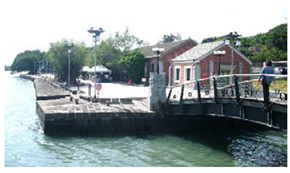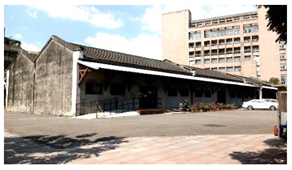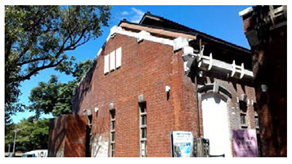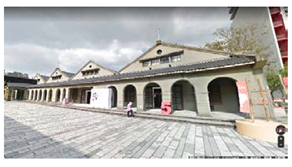Abstract
Brick warehouses represent a form of heritage at a different level of reactivation. Interdisciplinary exploration of social, cultural, and economic development has raised questions regarding the roles these buildings played in the past and how the heritage continued to evolve with the surrounding fabric. This study aimed to explore the spatiotemporal relationship between nine red brick warehouses and the historical development of the urban fabric in the Taipei metropolitan area, Taiwan. The relationship was defined by the quantitative trend assessment of the architecture, river, tributaries, and railroad, based on maps created between 1890 and 2020. The interactions between warehouses and fabric comprised single, meta, and determining indicators. The interactions evolved between two trends comprising intersections, maturity, and fluctuation. The consistent development of the architecture’s ascending trend was used as a reference indicator, by a relative scale to the fully developed stage of 100%. The meta-relationship between trends had a higher percentage and a greater occurrence closer to the present. The percentage totaled 67.74% after 1945 and remained above 50%, another indicator of the evolving frequency and intensity. The nine warehouses, which were part of a tributary branch system, created 11 intersections between 1950 and 1990. We concluded that the former active, supportive role of warehouses changed to a passive role, corresponding to the instrumentation of all trends. The warehouses functioned as trendsetters and interacted with the fabrics in a sustainable urbanization process. This was caused by role substitution, fabric replacement, degenerated dependence, and a diverted two-way relationship with hydrogeography. A geographic distribution of development was demonstrated from the river mouth inland.
1. Introduction
Warehouses were closely connected to the emergence and degeneration of regional agriculture and industry. The investment and related facilities have contributed to the transportation infrastructure and hydrogeography constructions for a long time. That investment contributed to the sustainability of the national economy and development. The definition and categories of cultural landscape have been discussed worldwide [1]. Warehouses are recognized as an industrial landscape [2] that affects people, places, and the environment [3]. Old industrial building types are evidence of vanishing traditions [4]. The elucidation of the relationship between warehouses and urban fabric can deepen our knowledge of tangible heritage according to different stages of development.
Warehouses’ development transformed more than 100 years ago in Taiwan. A small building in a relatively large urban area presented a slow pace of evolvement, subject to the nature of industry and its interaction with the surrounding fabric. The interaction accelerated the fabric degeneration or reactivation since 1880. The warehouse, as a part of the cultural landscape and heritage, represented an important intersection of historical trends affected by the specific timing of changes. A warehouse reveals the fabric evolvement through patterns that are categorized by locations, business types, land use, and urban infrastructure. The urban fabric may be demolished, filled up, leveled up, or reactivated for new construction sites or a new cultural landscape. The key events and periods of occurrence are of concern and should be identified to articulate the roles or hierarchies in the process.
1.1. Research Goal and Scope
All the brick warehouses are aged, reassembled by construction, or reactivated at different levels. Most of the original design is no longer functional. Questions have been raised regarding the roles of these heritage buildings in the past, how they reacted to the old fabric, and whether heritage continues to evolve with the surrounding fabric. This study assumes not only that a heritage building is connected to its past by the function that it provided, but that it is the interaction with the urban fabric that determines its trends and position today.
This study aimed to explore the spatiotemporal relationships between nine red brick warehouses and the historical development of the urban fabric in Taipei, Taiwan. The relationship was defined by the quantitative assessment of the architecture, river, tributaries, and railroad, based on the evolving history of the interaction between urbanization and traditional industry.
This study aimed to identify when and how the changes occurred. The range of the study started from the Qin Dynasty, the Japanese occupation period, to the present day in Taipei and its surrounding areas. As the economic and political center of Taiwan, the fabric covers the traditional municipal area, the Taipei metropolitan area, and the drainage basin of the Danshui River.
The nine red brick warehouses are industry buildings that were selected near or along the Danshui River, initially with different levels of dependence on irrigation or transportation (Figure 1 and Table 1). They are (1) Tamsui Custom warehouse (or “Tamsui”), (2) Former British Merchant warehouse (or “British”), (3) Taisugar Taipei warehouse (or “Taisugar”), (4) Old Mitsui & Co., Ltd. warehouse (or “Mitsui”), (5) former Camphor Refinery Workshop warehouse (or “Camphor”), (6) Songshan Tobacco Plant warehouse (or “Tobacco”), (7) Granary No. 1 (or “No. 1”), (8) Beitou Barn (or “Beitou”), and (9) Arsenal Warehouse No. 5 (or “No. 5”). They are selected and classified by characteristics, environments, industries, time periods, etc., into five categories.
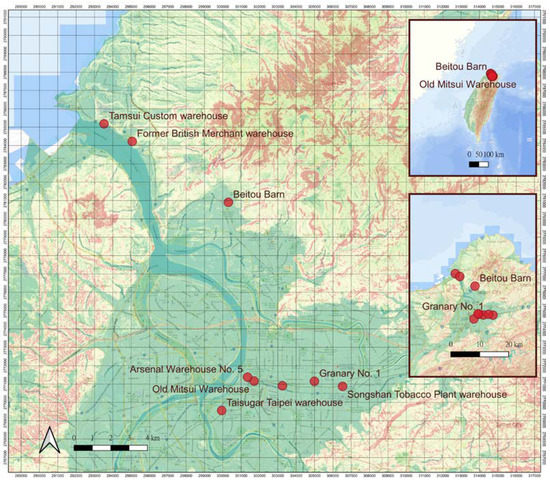
Figure 1.
Warehouses on maps [5] and their relationships with Tamsui River Basin.

Table 1.
Images and coordinates of each warehouse (WGS84 2021).
- The Tamsui Custom warehouse and the former British Merchant warehouse are located at the Danshui River mouth to support port logistics.
- The Taisugar Taipei warehouse is located near the Danshui River midstream for agricultural product processing.
- The Old Mitsui & Co., Ltd. warehouse is located near the old Taipei moat as a former trade office of Mitsui & Co., Tokyo, Japan.
- The former Camphor Refinery Workshop warehouse, Songshan Tobacco Plant warehouse, and Arsenal Warehouse No. 5 are industry warehouses, which had close connections with railway transportation.
- Granary No. 1 and Beitou Barn are grain warehouses located in the center of Taipei and by the Danshui River downstream near Guandu Plain.
1.2. Related Studies
Warehouses were hardly mentioned as part of the architectural culture except as factories [6]. The warehouse type may include small-scale industrial heritage [7], ancient salt plants [8], salt industry building [9], historic urban warehouses [10], tobacco warehouse and factory [11], olive oil warehouse [12], buried industrial architecture [13], power station [14], port city [15], rural carob warehouse [5], glazed ceramic factory [16], and barrel warehouse [17]. Even traditional irrigation systems provide a cultural landscape with a structure of traditional environmental knowledge [18].
Industrial architecture heritage involves issues such as reuse [19], urban planning, urban economy [7], rehabilitation [12], and translation of incoherent place identity [20]. Old buildings should be reused and integrated with the local culture [21]. The regional activation and cultural regeneration can be examined by using industrial facilities as cultural sites [14]. Reuse enriches the physical, environmental, and social performance [19]. The “cultural economy of reuse” can be seen, for example, in the trend for holding fashion shows in readymade spaces such as worn-out warehouses [22]. Industrial heritage also contributes to tourism [23] or serves as a sustainable development model [24]. The revaluation of old warehouses inevitably redefines their links to the evolving urban fabric.
Cultural landscape development is integrated with community revitalization [25,26]. As part of the landscape, warehouses or industrial buildings are related to the integration of the urban fabric [9], urban structure [13], urban renewal [27], regeneration interventions [28], cultural regeneration [14], engine of development [13], the recycling of existing buildings and infrastructure [10], urban safety, and seismic risk assessment and mitigation [29,30]. The protection and reuse of industrial heritage require public participation [31].
A significant relationship exists between the locations of warehouses and their spatial structure. Warehouses hold an irreplaceable position in logistics systems and supply chains [32]. The selection of a warehouse site involves the comparison of a market’s spatial characteristics. A GIS-aided process was applied to the selection of customer services and costs [33]. The spatial structure of changes involved land cost, tax, and infrastructure [34]. Significant differences may exist in the spatial scope of warehouse activity, even within the same urban area [35]. Overseas warehouses arise and effectively solve the problems of cross-border e-commerce [36]. The investigation of the relationship between warehouses and their spatial structure enables the comprehension of the former development of the urban fabric.
Land can be regarded as an engine for regional growth in terms of tourism, services, and infrastructure. Urbanization, land use alteration, and loss of functionality are factors that jeopardize heritage. Lehtovuori compared the urban space to a labyrinth [37]. Culture can be situated as an important structural factor influencing land systems [38]. Land use has been considered part of a sustainable model [39], and related changes have been estimated in urban areas for their possible impact [40]. The transition of land use illustrates the complexity of urbanization [41], which has occurred over the past 70 to 180 years [41,42,43,44] in the form of a matrix [45].
A study was performed to understand the active role of public waterscapes in cultural and political life [46]. The ever-changing relationship of the river and its city presented a productive ground for architectural and urban design experimentation [47]. A life cycle study indicates the life span of the river front [48]. The same situation also occurred for the irrigation systems that developed in earlier periods: social change has redefined the relationship between a target building’s function and hydrogeography.
The restoration of water ecological communities (WECs) is a critical issue for developing cities [49]. The renewal of the city waterfront can be both a top-down real estate transformation process and a bottom-up ecological restructuring process [50]. The redistribution of facilities and environmental regeneration are used to connect maritime and river fronts to the surrounding urban fabric [51]. Environmental flows describe water flow to sustain ecosystems that livelihoods depend upon [52]. However, rivers can be regulated and diverted without reaching the sea [53]. Water can be curtailed or diverted naturally or by human activity [52].
GIS, water, and heritage issues are closely related in the urban assessment of water-related natural hazards [54,55,56] or cultural ecosystem services [57]. With the assistance of remote sensing, advanced applications can be found in terms of structural change detection [58], the scope of natural hazards to heritage sites [59], or allocated irrigation water [60]. The relationship between water and heritage also opens up a conversation between the heritage and urban fabric, with the cultural landscape to be supported.
Industrial and warehouse buildings’ heritage should be carefully documented [61]. Architectural adaptation of a unique historical form, from an individual object to a territory, contributes to its integration into the urban fabric. The overlap of different moments in time stimulates social interaction [62]. The buildings transform our cultural identity from the past to the future [63]. The heritage forms a link in the creation and renovation of the urban fabric in the form of different organizations, constructions, and integrations. Heritage and port infrastructural remains have become one of the backbone principles of this type of redevelopment [28]. Analyzing the influence on local development links tangible and intangible heritage [18] and further extends to the cultural landscape of warehouses, rivers, tributaries, and railroads.
2. Materials and Methods
This study aimed to assess the local evolvement by trend and year, including a comparison of nine warehouses, four trend indicators, and the interactions between the trends of each warehouse. The four indicators of trends are the main Tamsui River, its tributaries (together representing the hydrogeography), architecture, and railroads.
A warehouse is usually located at the center of a targeted production area. The supporting fabric includes the river, irrigation system, and transportation system to deliver products. The evolvement of the production area and the scale of the transportation system were the indicators most directly related to development early on. The increase in production area and scale inevitably attracted population and businesses. However, the land supply in the peripheral area was limited. The water system was degenerated around the fabric of warehouses. As a result, the ever-expanding area of construction led to a decrease in production area, due to the growth of settlements, as one of the indicators of urbanization. Eventually, a turning point was reached when the original production industry was either relocated or became obsolete.
2.1. Map Resources
The assessments and comparisons aimed to identify when and how the changes occurred. To assess when a trend changed, it is necessary to relate two trends, since the urbanization process may have different types of impact, by referring to the area of architecture. The assessments referred to the map resources provided by the RCHSS Sinica webpages of the Historical Maps of Taiwan over the last 100 years [1] (Figure 2). Maps were selected to present the chronological evolvement of the fabric in intervals of 5–10 years or longer (Table 2). The differentiated level of years depended on the availability of maps. After compiling the available resources, maps were selected to compare the trends at a relatively comparable period of time in QGIS® (Figure 3). A certain tolerance was applied and illustrated in maps from 1945 and 1983 (Figure 3f) by 20.445 m (four measures).

Figure 2.
(a) Webpage titled “Historical Maps of Taiwan over 100 years” [6]; (b) webpage interface [6].

Table 2.
Examples of warehouse-related maps [1,64].
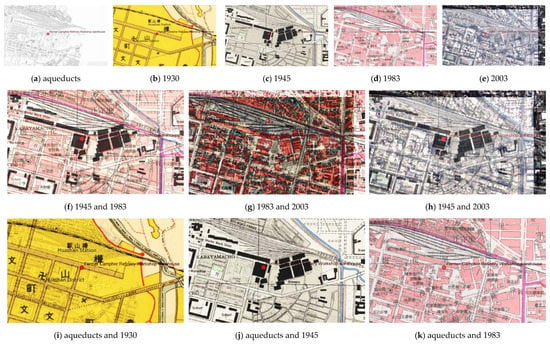
Figure 3.
(a–e) Historical maps around Former Camphor Refinery warehouse [1]; (f–h) the comparison between fabric in QGIS®; (i–k) overlaying aqueducts and historical fabric in QGIS®.
2.2. Meta-Indicators
The development of the research methods is represented by a flowchart with multiple indicators for each single warehouse, the collaboration of a single indicator across nine warehouses, and comparison tables of the percentage, difference, and occurrence of intersection (Figure 4). The interactions between warehouses and fabric comprise single, meta, and determining indicators. Single indicators include trends, stages, fluctuation frequency, and evolvement measured as a percentage. The meta-indicators comprise the interaction between two trends, such as intersections, maturity, differences, and fluctuation. Determining indicators were the maximum, minimum, or special measure of percentage for development.
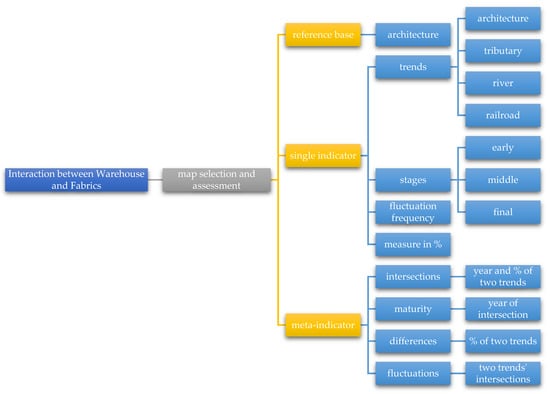
Figure 4.
Research flowchart and indicators for the interactions between warehouses and fabric.
2.2.1. Reference Base
The development of each trend had a maximum development scale of 100%, in terms of area or length. A value of 100% did not necessarily occur at the beginning or end of the entire trend. However, trends in architecture, which presented a more consistent ascending configuration for almost all of the warehouses, were used as a reference indicator for tributaries, river, and railroad. This indicator was used as it almost reached the maximum of 100% in recent years, and in the meantime, it denoted the end of other factors. This reflects the fabric substitution from agriculture to constructions.
2.2.2. Interactions between Trends
The interaction between two trends comprises intersections, maturity, differences, and fluctuation (Figure 5b). The related terminology is explained as follows.
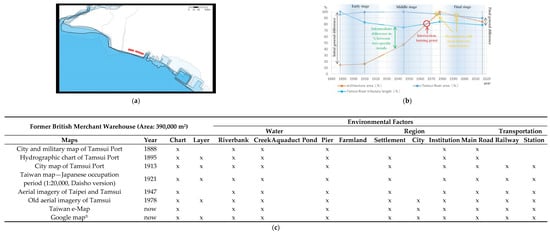
Figure 5.
Example of warehouse-related (a) overlaid evolvement, (b) percentage in development, and (c) involved maps [5,64] and available environmental factors over the years.
- Indicators: The four indicators of trends are the main Tamsui River, its tributaries (together representing the hydrogeography), architecture, and railroad.
- Measures: This refers to the area or length of architecture, river, tributaries, and railroad. Take the fully developed area or length as 100% and assess the relative % in each year by tracing historical maps.
- Trend: The % of measures made by each indicator over a number of years.
- Intersection: Different types of trends of the same warehouse, placed together, may intersect with each other. This is an important indicator to specify the shared turning point of change between two trends in the early, middle, or final stages.
- Difference: the range of percentage between two trends in a specific year.
- Maturity: The maturity of an indicator generally occurs after the intersection has reached a certain point, in terms of years, stages, and the percentage value. It is related to regional development, geographic characteristics, and evolving patterns.
- Fluctuation: It represents the frequency of occurrence caused by the intersection. It becomes a meta-indicator when more than one intersection occurs between two trends—for example, architecture and railroad. The fluctuation in the percentage indicated the specific status of a trend generally but not consistently, in an ascending or descending manner.
A difference before or after intersection indicates being behind or ahead of development in a particular stage. Stages usually presented a difference at various levels of percentage. Two trends with a large early difference tended to display an intersection in later years. The distribution of intersections draws attention to occurrences other than high percentage in recent years and low percentage in early years. For example, the interaction formed in the early years and in a lower percentage indicates that exceeding the development of a certain measure type led to a prevailing trend in the beginning. An interaction formed in later years and in the top percentage means that the development of a certain measure type finally reached a mature stage after long-term evolvement. The interactions formed in middle years and percentage indicated a back-and-forth development trend.
Relative and absolute values were applied to illustrate the possible range of difference. The relative percentage further defined the meta-quantitative classification of two indicators by various percentage levels of difference and revealed their interaction prior to inducing a relationship. The absolute difference merely presented the mathematical difference by subtracting the positive or negative percentage of the early stage from the final one. The result, which ranged between sub-0% and 200%, represented the development of architecture from falling behind to exceeding the percentage of railroad, for example.
2.2.3. Assessment
The layered maps highlighted the changes made to a specific measure type or region by boundary or length. Each warehouse had layered maps of evolvement (Figure 5a) that overlapped and were reviewed based on hydrogeography-, architecture-, and transportation-related information in a chart (Figure 5b), including the available environmental factors (Figure 5c). Maps, with very limited information available other than images, were regenerated in AutoCAD® into vector drawings to assess the area or length within a defined boundary.
Charts were created to compare the ascending and descending trends of the three to four indicators in percentages, with reference to the maximum amount of 100% (Figure 5b). As the year of development was defined by the x-axis, the vertical axis was the percentage when the stage was presented in a relative scale to the fully developed stage at 100% (Figure 5b). The percentage of each marked year represented the particular quantitative value of the evolving status of a certain measure or fabric type (i.e., architecture, river, tributaries, or railroad).
The charts elucidated the historical positioning and function of a warehouse and illustrated the changes that evolved along a trend’s timeline. The trends enabled the quantitative assessment of evolvement and the crucial years by the intersection in between. The charts extend the comprehension of each warehouse to the whole perspective of the urban fabric. The same types of trends were also collected and compared across the nine warehouses to confirm the similarity or difference between them. The individual charts illustrated a deduced meta-trend of the warehouse in the metropolitan Taipei area. The combined charts clarified the differences by geographic distribution and warehouse type. The cross-comparison demonstrated the role of each warehouse and enabled a more differentiated investigation of the related fabric.
3. Results
The warehouse, which symbolized the hydrogeography-based urban fabric development, played an active role in defining the old center of development by specific geographic locations. The charts in Figure 6 point out ascending and descending trends as collected indicators of agriculture or industry. The years of intersection indicate turning points of urban development. It should be noted that diversity existed even in the nine warehouses in metropolitan Taipei, with ascending trends in architecture or descending trends in rivers, irrigation systems, or mass transportation systems. The active role has been reshaped into a passive role.
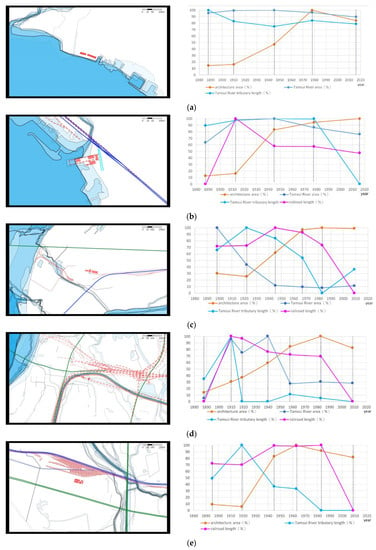
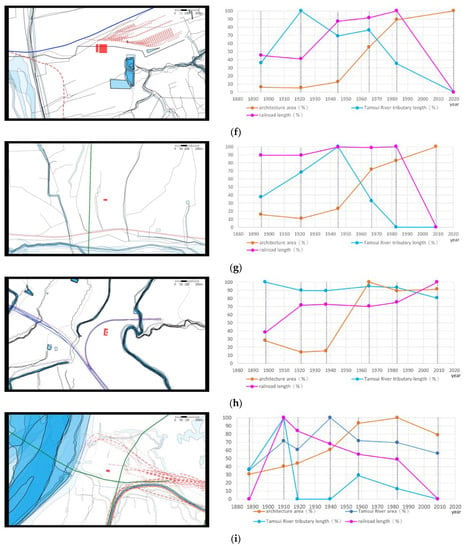
Figure 6.
Target area and cross-referred trends between architecture, hydrogeography, and railroad of each warehouse: (a) Tamsui Custom warehouse: 8400 m2; (b) Former British Merchant warehouse: 16,800 m2; (c) Taisugar Taipei warehouse: 11,080 m2; (d) Old Mitsui & Co., Ltd. warehouse: 2330 m2; (e) Former Camphor Refinery Workshop warehouse: 4680 m2; (f) Songshan Tobacco Plant warehouse: 1000 m2; (g) Granary No. 1: 600 m2; (h) Beitou Barn: 2080 m2; (i) Arsenal Warehouse No. 5: 260 m2.
3.1. Single Warehouse
Nine warehouses were explored based on the target area and cross-referred trends between architecture, hydrogeography, and railroad (Figure 6).
- Tamsui Custom warehouse (or “Tamsui”): The hydrogeography remained relatively stable. The increasing architectural area presented a significant contrast between the early and final stages.
- Former British Merchant warehouse (or “British”): The area of hydrogeography decreased in the Danshui River tributaries, which were leveled for parks and architecture. The ascending and descending trends of the railroad, which were promoted by the export of goods to Japan, were partially destroyed by air raids during World War II (WWII). This warehouse was one of the only two where the railroad trend was not reduced to 0% at the final period of development.
- Taisugar Taipei warehouse (or “Taisugar”): The prevailing sugar industry and the early demands for irrigation systems degenerated significantly due to river sediment and the rapidly expanded scale of urbanization around the Taisugar Taipei warehouse. The sugar industry was almost destroyed during WWII, and the same land was transformed for other agriculture uses. The river front was redeveloped as a diversified reactivation for wild goose preserve.
- Old Mitsui & Co., Ltd. warehouse (or “Mitsui”): This was a business-oriented center, which presented a rather similar pattern to that of Taisugar. In contrast to the increasing density of buildings, the Taipei West Gateway Project has created open spaces in this area. In this case, all four trends decreased in the last period of development.
- Former Camphor Refinery Workshop warehouse (or “Camphor”): It presented a rather similar pattern to Taisugar. In contrast to the increasing density of buildings, the Taipei West Gateway Project has replotted open spaces in this area.
- Songshan Tobacco Plant warehouse (or “Tobacco”): This was one of the two warehouses that had the same ascending development pattern in another period, between 1945 and 1965, at a delayed pace of development. The key transportation facility of the main train station represented the apex of urbanization. The two main examples of the evolvement in architecture were the additional military village for retired soldiers and their families and the new city center to the east of Taipei.
- Granary No. 1 (or “No. 1”): This building had the same ascending development pattern between 1921 and 1945, at a delayed pace of development. The key transportation facility and main bus station represented the apex of local urbanization. The demolished open-air water conduits became part of the city center. The underground project of the railroad, which relieved open space at the ground level, contributed to another major phase of evolvement.
- Beitou Barn (or “Beitou”): This displayed another railroad trend not reduced to 0% and the only one whose trend ascended at the last period of development from the additional Taipei Mass Repaid Transit (MRT) maintenance workshop and the open-air railroad design at the ground level.
- Arsenal Warehouse No. 5 (or “No. 5”): The Taipei West Gateway Project alleviated the pressure on the fabric and replaced the fabric with more open space. This warehouse was one of two with consistent ascending and descending trends in the early and final stages.
In brief, for three out of nine warehouses, all three or four types of trends ascended at the first period of development, between 1888 and 1910 or 1888 and 1913 (Former British Merchant warehouse, Old Mitsui & Co., Ltd. warehouse, Arsenal Warehouse No. 5), and three decreased in the last period (Tamsui Custom warehouse, Old Mitsui & Co., Ltd. warehouse, Arsenal Warehouse No. 5). Two had the same ascending development pattern in another period, between 1921 and 1945 (Granary No. 1) or 1945 and 1965 (Songshan Tobacco Plant warehouse), separately, at a delayed pace.
In other words, among all the phases, eight of them presented the same ascending or descending trends during the 45 periods, at a percentage of 17.8%. Two of them shared the same ascending and descending trends in the early and final stages (Old Mitsui & Co., Ltd. warehouse, Arsenal Warehouse No. 5).
3.2. Nine Warehouses
The ever-increasing urbanization accelerated the development and transformation of land for alternative use. Urban regeneration led to different trails in completely opposite development directions on the river front. The warehouses located next to the Danshui River represented the dependence on the port near the river mouth. The process accelerated as former agricultural land was developed. Tributaries were either leveled or transferred underground to allow more diversified uses of the land.
- Architecture: The fabric around warehouses shared similar ascending trends of development, subjected to different levels of former reclamation and construction (Figure 7a). Taipei was the economic and political center since the Qin Dynasty. The Taisugar warehouse was located in an area with a highly developed harbor and commercial settlements, in contrast to the agriculture-based warehouses located toward the inland area. The former Camphor Refinery Workshop warehouse was located in a highly urbanized area in 1945, in contrast to the late development around the Songshan Tobacco Plant warehouse, in a peripheral area. The percentage descended at a later period in half of the warehouses, as the urbanization was not expanded in an unlimited manner.
- Tamsui River mainstream: The main body of the Danshui River remained relatively stable, compared to the development of the tributaries, with the exception that the natural deposition and man-made constructions occurred at the river fronts (Figure 7b). Each warehouse had a rather different starting percentage in the early stage, depending on the geographic distribution of the upstream, middle, and downstream regions. The changes were caused by sediment deposition from a major tributary in the upstream and swans in the midstream. The river remediation was intensified along with the development of old Taipei city in the early days and then lessened in the period of the ROC government. Most inland warehouses were located in the midstream, where the water area was reduced, and new land was reclaimed as hinterland to the west of Taipei.
- Tamsui River tributary: All the tributaries presented descending trends, except that a wild goose preservation area was established with ponds and a branch system (Figure 7c). This new policy meant that a versatile hydrogeography system developed after the industrialization and urbanization of the 1980s.
- Railroad: The majority of the warehouses presented rapidly descending trends from the 1980s onwards. Only two warehouses did not have their railroad trends reduced to 0%. Beitou Barn reversed the trend with the new construction of an MRT system (Figure 7d), and it was the only one whose trend ascended at the final period of development. The Tamsui warehouse did not have a railroad within the defined boundary.
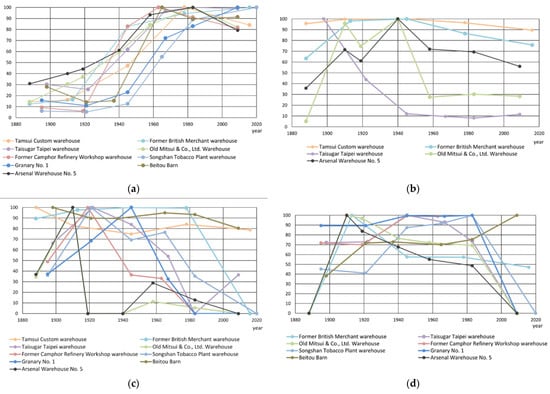
Figure 7.
Evolving trends of the changes by percentage: (a) architecture area; (b) Tamsui River mainstream area; (c) Tamsui River tributary length; (d) railroad length.
In general, the following findings were based on the counted numbers and types of intersections (Figure 8). The higher the counted numbers were, the larger the impact exerted on the infrastructure and the tributaries. The lower the counted numbers were, the less the impact exerted on the river. In general, the most significant changes in warehouses occurred in the Old Mitsui & Co., Ltd. warehouse and Beitou Barn, in which five intersections occurred, with two downward and three upward trends. Moreover, the alterations caused dramatic changes to be made much earlier than in the latter case, with a difference of approximately 40 years from 1950 to 1990.
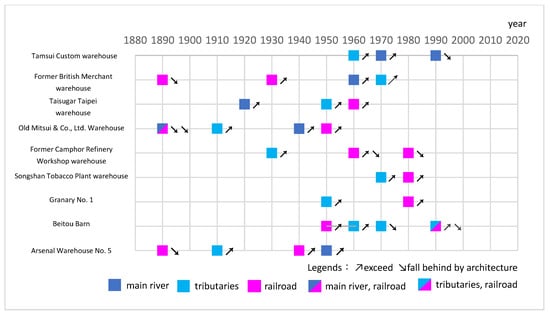
Figure 8.
Occurrence of trend intersections between architecture, river, tributaries, and railroad, with arrows showing ascending or descending trends after the turning point.
3.3. Relationships between Trends
Figure 9 overlays all the intersections between hydrogeography, architecture, and railroad by years and percentages. The intersections occurred closer to the present, presenting higher percentages and more occurrences. In total, the values above 50% amounted to 67.74% after 1945, as another indicator of the evolving frequency and intensity. The ascending trend of architecture was accompanied by the descending of others, such as rivers, tributaries, and railroads. The fabric evolved as a consequence of urbanization from agriculture and industry to services, confirming the instrumentation to reactivate the environment.
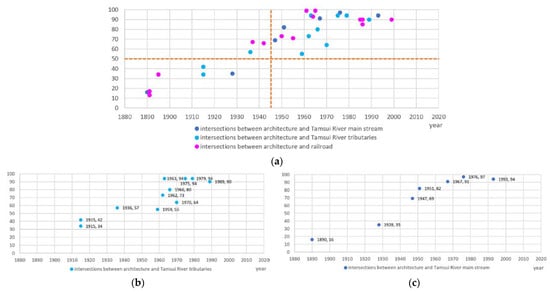
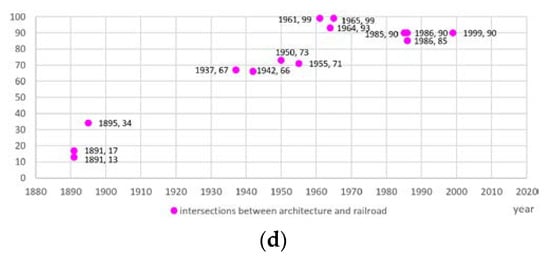
Figure 9.
(a) Distribution of trend intersections between architecture, hydrogeography (tributary, river), and railroad; (b) between architecture and tributary; (c) between architecture and river; (d) between architecture and railroad.
3.3.1. Architecture–Tributary Distribution Difference
The intersections that occurred closer to the present had higher percentages and more occurrences, since architectural development reached a higher percentage only in recent decades. The nine warehouses, which were located as part of the branch system, created 11 intersections between 1950 and 1990 (Figure 9).
The mature year, which was the breaking year when the tributaries intersected with architecture, represents when the percentage of architecture exceeded that of the tributaries. Architecture generally started low and reached a high level in an ascending trend. Three types of declined tributary trends intersected with a relatively consistent ascending trend of architecture. Three types of maturity were presented, and different roles emerged in less agricultural areas and with warehouses regenerated in different layouts. Since the trend of architecture generally started at a very small percentage, these mature years represented the remodeling of the irrigation system, which was conducted from a very early stage.
Early matured warehouses (Mitsui, No. 5), as they intersected in the early stage, presented early decline and development. This stage presented early urbanization, with a smaller percentage difference in the early stage and a larger percentage difference in the final stage for commercial or industry/machinery types of warehouses. The majority of warehouses were moderately matured (Taisugar, Camphor, Tobacco, No. 1) under moderate declination and development and intersected in the middle stage. Final matured warehouses (Tamsui, British, Beitou), which intersected in the final stage, presented a final decline and development. This stage presented finalization and a lesser change in role or urbanization, presenting a larger percentage difference in the early stage and a very small percentage difference in the final stage (except British).
Architecture caught up with the tributaries via the river in a stable manner. Two warehouses, which presented intersections in the final stage, were located by the river at either a consistent percentage or with a final decline. A unique switched matured situation occurred in the British case, caused by a rapid tributary decline after the intersection, and resulted in a difference in the final stage. Mitsui and No. 5 presented early deprived tributaries in the irrigation system. Taisugar re-emerged at the final stage on the river front.
3.3.2. Architecture–River Distribution Difference
Architecture and the river intersected in ascending and descending trails under different frequencies and percentages. Five warehouses, which were located as part of the river system, created seven intersections (Figure 9). The higher percentages occurred more recently, since architectural development reached a higher percentage only in recent decades between 1960 and 1980.
The distribution illustrated two intersections by two groups, in which the intersections were created in the early days at the beginning of the ascending or descending trends by a small portion or more recently by reaching the top of the ascending trend in a larger portion. The intersections that occurred closer to the present had a higher percentage of water surface area, in which the geographic distribution was the main reason for being located near the Danshui River in a less altered boundary. Otherwise, warehouses were located more inland.
The river presented a less consistent trend between warehouses, except for two warehouses located near the river mouth (Tamsui, British). Two warehouses had intersections that formed earlier, when the area of the river was reduced by sediment. The commercially oriented Old Mitsui & Co., Ltd. warehouse, which had a weaker connection with the support of the Tamsui River, was elevated with a significant difference, from less than 10% to 100% and then 30%. The Taisugar Taipei warehouse, with a stronger connection to the Danshui River, also experienced an elevation and then descended rapidly, with a significant nonfluctuation rate.
3.3.3. Architecture–Railroad Distribution Difference
The intersections that occurred closer to the present had a higher percentage and more frequent occurrence. Eight warehouses, which were located as part of the branch system, created 14 intersections (Figure 9). The higher percentages occurred more recently, instead of reaching an apex, since urbanization instrumentation restructured the transportation system or transferred it underground. The railroad exceeded architecture only in four warehouses near 1890 (British, Mitsui), 1895 (No. 5), and 2000 (Beitou). Only one warehouse, Tamsui, did not have a railroad nearby.
The frequency of intersections explains the intensity of the fluctuation formed between the two trends of architecture and railroad. Railroads with ascending and descending trends intersected architecture at five warehouses under different frequencies and percentages. The Camphor and Beitou warehouses, which fluctuated at a high percentage, are located next to current transportation facilities, as a type of fabric that maintained or extended a previous function. The important role of the railroad changed differently in the early, middle, and final stages. The two warehouses’ roles also changed. Camphor, with a higher fluctuation rate at the top of the ascending trend, presented a rapid drop, descending in the final stage.
4. Discussions
The former active, supportive role of warehouses turned into a passive role due to the active approach of urban instrumentation by the river front, tributaries, building areas, and traffic infrastructure. The transferred functionality and roles enabled the determining factors to be assessed by the years of intersection.
A two-way process was applied to define the relationship between hydrogeography and other parts of the urban fabric. The river front changed from outreached, modified, covered up, and leveled up to completely demolished, as the most explicit interaction was formed between the hydrogeography and a farm field, community, or city. The tributaries either dominated a place as a cultural relic or disappeared due to leveling up or being transferred underground.
A warehouse is a perfect symbol since it is directly linked to the local development from agriculture to industry or commercial use. If the viewpoint is switched to the fabric that took advantage of the hydrogeography, the fabric in the surrounding area also reveals a scenario in which the role of the directly related artifacts has been modified under a more specific interpretation of development or degeneration. The existing fabric responds to hydrogeography by reactivation or policy amendment, with some warehouses even reallocated from old moat heritage to fit into the fabric of today (i.e., Old Mitsui & Co., Ltd. warehouse).
4.1. Architecture-Based Collaborative Analysis
Architecture was the basis for a comparison with environmental factors (river, tributaries, and railroad), and we summarized their intersections as the trends developed over the years. The trends were illustrated when a factor was ahead of or behind another by an ascending or descending arrow (Figure 8). The relationships between architecture, hydrogeography, and railroad represented their interactions with land use, resources, and infrastructure. The intersections determined when the old system changed and the cause of the change.
Most of the warehouses had one or more trends that started at a high percentage, even since the 1890s. Very few of them started from scratch, with the exception of architecture. This highlighted the evolvement of architecture, which gradually took the dominant position over 140 years. For a more general comparison of distribution by stages and percentage, Table 3 demonstrates that the majority of the general differences were large, if the upper and lower boundaries were considered together with architecture, rivers, tributaries, or railroads combined.

Table 3.
General differences between warehouses.
4.2. Geographic Distribution of Tributaries
Map-based 3D bar charts in percentages present the assessment of a warehouse’s maturity and its distribution on a map (Figure 10). The geographic distribution of development was assessed from the river mouth inland. The river mouth is a unique location that can facilitate culture [65]. The early or late intersection presented an oriented transformation of a tributary from a general “increase–decline” to “increase–early decline”, in which the hydrogeography was an important determining factor to evaluate the growth of urbanization by architecture. The early intersection was located inland, with fewer agriculture-related factors, or toward a transformed business or urban center. The late intersection presented delayed development, with a “highly consistent tributary percentage” close to the river mouth.

Figure 10.
Geographic location of warehouses and the percentage when architecture intersected with the trends of tributaries, Tamsui River, and railroads (only the first or major one was selected).
The relation to hydrogeography classified the dependence of warehouses either on the transportation of products or materials, irrigation for agriculture products, or not related as commercial or industrial emphases. The interaction between architecture and tributaries presented geographic movement in a single intersection for the majority of situations. Different types applied. The interaction between architecture and railroad presented more frequent intersections that were entangled and showed immediate or delayed descending trends afterward. As a result, an interaction occurred between architecture and tributaries that presented lower development intensity but a much larger scale than the interaction formed between architecture and railroad. Both types of interactions and intersections clarified the relatively more chaotic configurations of trends that occurred between the hydrogeography and railroad. Moreover, the fluctuation frequency in railroads presented a more diversified characteristic, concurrently presented with that of hydrogeography.
Geographic distribution in hydrogeography was an indicator to evaluate the change in trend by percentage and also determined how the evolving pace was classified. The two-way process comprised the reoriented influence, valuation, and policy making between the situation of the past and the present. It seems that the irreversible process will permanently change the urban fabric and the old cultural landscape.
4.3. Railroad Trend Fluctuation
The level of fluctuation was a strong indicator presented by railroads. The fluctuation and steady ascending or descending trends of railroads presented a well-covered spectrum for the quantitative assessment of increased and decreased parts of the fabric. The greater the fluctuation of the percentage presented, the more development occurred around a certain warehouse. In general, the final difference was higher than that of the early stage. The fluctuation of railroad percentage vs. the steadily ascending percentage of architecture presented another dynamic reference for the evolving fabric, compared to the generally descending percentage of tributary systems. Intensive fluctuation occurred for Mitsui and No. 5, in which both the early and final percentages were zero. However, a value of 100% occurred in between, similar to most of the others, except that of the Beitou Warehouse, which occurred at the final stage.
The degenerated railroad presented a more consistent degeneration trend than that of hydrogeography among warehouses. It was noted that the former railroad-related transportation dependence of hydrogeography (the warehouse was reached by both river and railroad) was seen directly in only one warehouse recently and presented an indirect or unrelated dependence for the remaining eight warehouses in the present period. In contrast, the weakened or indirect connection to hydrogeography was not compensated for by a higher dependence on railroads. The fast decline in the railroad presented an unexpected degeneration rate or the rapid replacement of the existing railroad system. Consequently, solid proof of the changing role and degenerated function was accompanied by a descending trend of the former supporting facilities. Whether the indicators interacted as a mutual influence remains to be studied, since the earlier production system and infrastructure either degenerated or evolved into completely different systems. Nevertheless, the fabric presented partial evidence of the changes made to the environment.
4.4. Sustainable Fabric Revisions
Either the fabric formulated the warehouse, or the warehouse formulated the fabric. The hydrogeography predetermined the characteristics of a site and industry and consequently highlighted the geographic distribution of a warehouse. The early fabric evolved with the ascending or descending demands of infrastructure, which also defined the fabric afterward. Both trends presented different paces of evolvement, as defined by when the railroad intersected with the architecture.
Sustainable cities and communities contribute to heritage and related development goals [66]. Urban resilience and sustainability involve water management and urban ecosystem services in neighborhoods [67,68,69]. When the focus of hydrogeography was switched to its beneficial subjects, such as warehouses installed by early agencies for specific goods and transportation needs, the transformed functionality evidenced the degenerated value of the water-related system, while the role of drainage or irrigation was only shared by the former industry culture.
Tributaries and architecture were the two dominant indicators of urbanization in the recent land supply. Facility redistribution and environmental regeneration were used to connect maritime and river fronts to the surrounding urban fabric [51]. The degeneration of the hydrogeography system occurred in different ways or was reactivated. The modification could be seen when the river front regeneration changed the landscape by restraining housing development. As a result, the fabric can be updated from the existing one, or the river front may be extended outward.
Warehouses were created based on agricultural or industrial demands for storage and distribution. The latter depended heavily on transportation, i.e., rivers, in the early days. The scope was enlarged to that of a city, in which the hydrogeography system included rivers and harbors. The dependence on rivers or irrigation systems comprised different relationships once the dependence was no longer necessary. Since the scale of urbanization was also enlarged, new zoning was replotted (industry moved out of a city, for example) or the transportation infrastructure was upgraded to an MRT system.
The highly related urbanization almost spelled the demise of the warehouses. The evolved fabric promoted the awareness and preservation of the cultural heritage and prevented it from being demolished. It seemed that all the trends were reversible, i.e., constrained architecture for river front regeneration; demolished railroads were regenerated into MRT. However, the degeneration rate in the early period significantly exceeded the regeneration rate of the area. The reversed fabric may or may not reverse the role of the warehouse, except in terms of remodeling space for cultural reactivation or creative industries. The overdeveloped fabric again revised the role of the warehouses as a possible supporting basis for new ones.
4.5. Difference, Maturity, and Fluctuation Rate
The differentiated trends of each warehouse consist of the relative difference and absolute difference. Table 4 presents the relative difference of two or three trends by subtracting the percentage from architecture’s and the absolute difference by subtracting the value of the final stage from the early ones. A low difference value in the early stage was generally followed by a higher value in the final stage as proof of accelerated development. Intersection occurring at the final stage as an apex usually presented a similar level of development to architecture. Each warehouse at least presented one maximum or minimum value in the early or final stage, as a unique indication of status compared to others along its evolutionary history. The former Camphor Refinery Workshop warehouse was the only one without any maximum or minimum value.

Table 4.
Differentiation between architecture, hydrogeography, and railroad of each warehouse by relative and absolute difference.
The higher the number of intersections between two trends, the higher the fluctuation rate of fabric alternation. Table 5 presents the maturity and fluctuation rate of each warehouse in terms of stages and percentage levels. Although most warehouses had one or two intersections, a set of three intersections occurred at Beitou Barn between architecture and tributaries in the final stage (Figure 6h).

Table 5.
Differentiation between each warehouse by maturity and fluctuation rate of trend.
5. Conclusions
Urbanization, land use alteration, and loss of functionality are factors that jeopardize heritage. Analyzing the influence on local development links the tangible and intangible heritage and further extends to the cultural landscape of warehouses, rivers, tributaries, and railroads. While small-scale industrial heritage from the building trade was applied as a vehicle for the productive city [7], the accessibility of different warehouses at the same time [28] was needed in the study of public spaces and their heritage role.
In this study, the charts enabled a two-way evaluation process of the influence of urbanization on the regions around the warehouses. In general, the outward service and management of warehouses in the early days was followed by the inward impact of land use transfer and reduced demands of agriculture and sugarcane. The original role, as a manager and distributor of rice and industrial products, was combined with the role of resource owner and provider of the land.
The changing roles altered all aspects, from the function of the warehouse to the land supplied by the replaced fabric. We concluded that the evolvement was caused by the role substitution, fabric replacement, degenerated dependence, and diverted two-way relationship with hydrogeography. We found that the early accomplishments of the facilities to meet the function-dependent demands were eventually replaced by the shortage or diverted need of land supply. While the urbanization was explored first, the change came from the exceeded development pace in peripheral areas rather than the warehouse or the hydrogeography itself.
The warehouses functioned as trendsetters and controlled how the fabric developed, in terms of layout, infrastructure, or transportation system. After the warehouses remained unchanged for several decades, all the evolved urban factors contributed to redefining the warehouses in specific years under specific trends. The spatial order of the warehouses changed when they were subjected to the order of the urban fabric, which was initially defined by them. The role substitution or fabric replacement contributed to positive and negative impacts. The former could be favored by the community as a remodeling. The latter would lead to the demolition of the cultural landscape.
This work has presented a warehouse-centered study of trends. Future research could explore more factors besides architecture in assessing the historical evolvement of the urban fabric.
Author Contributions
Conceptualization, methodology, software, validation, formal analysis, investigation, writing—original draft preparation, visualization, and data curation, N.-J.S. and Y.-C.W.; resources, writing—review and editing, supervision, project administration, and funding acquisition, N.-J.S. All authors have read and agreed to the published version of the manuscript.
Funding
This research was funded by the Ministry of Science and Technology of Taiwan, MOST 110-2221-E-011-051-MY3. The authors express their sincere appreciation.
Institutional Review Board Statement
Not applicable.
Informed Consent Statement
Not applicable.
Data Availability Statement
Not applicable.
Acknowledgments
The information applied in this study can be accessed from Taiwan Map Service-National Land Surveying and Mapping Center (NLSC); RCHSS, Center for GIS, Academia Sinica, Taiwan. The authors would like to express sincere appreciation for their support.
Conflicts of Interest
The authors declare no conflict of interest.
References
- Brumann, C.; Gfeller, A. Cultural landscapes and the UNESCO World Heritage List: Perpetuating European dominance. Int. J. Heritage Stud. 2021, 28, 147–162. [Google Scholar] [CrossRef]
- Keweenaw National Historical Park, Cultural Landscapes Inventory, Calumet & Hecla Warehouse Number One, National Park Service. Available online: https://npshistory.com/publications/kewe/cli-calumet-hecla-warehouse-1.pdf (accessed on 7 August 2022).
- Jacobson, E. Industrial Landscape Preservation: An Expanded Approach to Protect the Working Small Town. Master’s Thesis, University of Washington, Seattle, WA, USA, 2012. Available online: https://digital.lib.washington.edu/researchworks/bitstream/handle/1773/22508/Jacobson_washington_0250O_11230.pdf?sequence=1 (accessed on 7 August 2022).
- Vehbi, B.O.; Yuceer, H.; Hurol, Y. Rural carob warehouses in Cyprus: An assessment of architectural and structural characteristics. J. Arch. Conserv. 2016, 22, 18–47. [Google Scholar] [CrossRef]
- RCHSS. Center for GIS. Keelung Historical Maps. Academia Sinica, Taiwan. Available online: http://gissrv4.sinica.edu.tw/gis/keelung.aspx (accessed on 18 July 2021).
- Frampton, K. Notes of British Architectural culture 1945–1965. RA-Revista de Arquitectura 2012, 14, 108–114. [Google Scholar]
- Vandyck, R.; Degraeve, M. ‘Baukultur’ in Brussels: Small-scale industrial heritage from the building trade as vehicle for the productive city. KNOB Bull. 2019, 118, 20–35. [Google Scholar] [CrossRef]
- Fiskovic, I. The Town of Pag—An Example of a 15th Century “Real Town”. Prostor 2012, 20, 32–45. [Google Scholar]
- Yang, L.; Li, K. Study on the Cultural Value of the World Heritage of Salt Industry. In Proceedings of the 4th International Conference on Economy, Judicature, Administration and Humanitarian Projects (JAHP 2019), Advances in Economics, Business and Management Research, Kaifeng, China, 12–14 September 2019; Volume 94, pp. 120–126. [Google Scholar]
- De Fosse, M. Historic urban warehouses in Brussels: Architecture and construction. Bruss. Stud. 2017, 117, 1–17. [Google Scholar] [CrossRef]
- Bluestone, D. Tobacco Row: Heritage, Environment, and Adaptive Reuse in Richmond, Virginia. Chang. Over Time 2012, 2, 132–154. [Google Scholar] [CrossRef]
- Alarcon, S.P. Industrial agricultural architecture: The network of olive oil warehouses of the Sindicato Vertical del Olivo, 1945–1960. Biblio 3W-Barc. 2020, 25, 1–26. [Google Scholar]
- Rizo-Maestre, C.; Echarri-Iribarren, V.; Prado-Govea, R.; Pujol-Lopez, F. Radon Gas as an Indicator for Air Quality Control in Buried Industrial Architecture: Rehabilitation of the Old Britanica Warehouses in Alicante for a Tourist Site. Sustainability 2019, 11, 4692. [Google Scholar] [CrossRef]
- Vizzarri, C.; Sangiorgio, V.; Fatiguso, F.; Calderazzi, A. A holistic approach for the adaptive reuse project selection: The case of the former Enel power station in Bari. Land Use Policy 2021, 111, 105709. [Google Scholar] [CrossRef]
- Chung, H.; Lee, J. A study on cultural urban regeneration using modern industrial resources: Focusing on the site-specific cultural places of Gunsan, South Korea. Land 2021, 10, 1184. [Google Scholar] [CrossRef]
- Cutulle, A. A case of industrial heritage: The Ceramica Ligure Vaccari. Ge-Conservation 2017, 11, 110–113. [Google Scholar] [CrossRef]
- City of Waterloo. Cultural Heritage Report, 2019. Available online: https://www.waterloo.ca/en/government/resources/Documents/Cityadministration/Cultural-Heritage-Landscapes-Study/Cultural-Heritage-Landscapes-Inventory.pdf (accessed on 7 August 2022).
- Martínez-Sanchis, I.; Viñals, M.J. Enhancing the traditional Mediterranean irrigation agroecosystems: A case study of the rivers Túria and Júcar (Valencia, Spain). WIT Trans. Ecol. Environ. 2015, 192, 45–54. [Google Scholar] [CrossRef]
- Alpler, Z.B.; Şahin, N.P.; Dağlı, U.U. A critical discussion of industrial heritage buildings adaptive re-use as film spaces, case study: Industrial heritage buildings at Istanbul. J. Arch. Conserv. 2020, 26, 215–234. [Google Scholar] [CrossRef]
- Mathews, V. Lofts in translation: Gentrification in the Warehouse District, Regina, Saskatchewan. Can. Geogr. 2019, 63, 284–296. [Google Scholar] [CrossRef]
- Zhang, W. Local Culture on the Reuse of Old Buildings in Industrial Area—An Urban Design Proposal for the Mufu Mountain Area in Nanjing, Master of Science Programme in Spatial Planning with an Emphasis on Urban Design in China and Europe, May 2012, Karlskrona, Sweden. Available online: https://www.diva-portal.org/smash/get/diva2:829381/FULLTEXT01.pdf (accessed on 7 August 2022).
- Strömberg, P. Industrial Chic: Fashion Shows in Readymade Spaces. Fash. Theory 2017, 23, 25–56. [Google Scholar] [CrossRef]
- Berkenbosch, K.; Groote, P.; Stoffelen, A. Industrial heritage in tourism marketing: Legitimizing post-industrial development strategies of the Ruhr Region, Germany. J. Heritage Tour. 2022, 17, 327–341. [Google Scholar] [CrossRef]
- Moral-Moral, M.; Fernandez-Alles, M.T. Perceptions of the Local Resident to Industrial Tourism as a Sustainable Development Model. Rev. De Estud. Reg. 2019, 114, 45–69. Available online: http://www.revistaestudiosregionales.com/documentos/articulos/pdf-articulo-2561.pdf (accessed on 10 August 2022).
- Shen, J.; Chou, R.-J. Cultural Landscape Development Integrated with Rural Revitalization: A Case Study of Songkou Ancient Town. Land 2021, 10, 406. [Google Scholar] [CrossRef]
- Shih, N.-J.; Lin, C.-Y. The evolving urban fabric and contour of old mountain streets in Taiwan. Tour. Geogr. 2017, 21, 24–53. [Google Scholar] [CrossRef]
- Yu, Y.F. Industrial Heritage in Shanghai—Past, Current Status and Future Direction. Ind. Patrimony 2012, 49–55. Available online: http://openarchive.icomos.org/id/eprint/1313/1/YU_Yifan-Paris.pdf (accessed on 7 August 2022).
- Leon, C.I.; Sapa, E.L.R. Hafencity-Speicherstadt: Accessibility and heritage in the regeneration of an urban ensemble. Loggia Arquit. Restauración 2020, 33, 8–19. [Google Scholar] [CrossRef]
- Vallis, S.; Gálvez, F.; Swidan, M.; Orchiston, C.; Ingham, J. Classical Temples and Industrial Stores: Survey Analysis of Historic Unreinforced Masonry (URM) Precincts to Inform Urban Seismic Risk Mitigation. Int. J. Arch. Heritage 2018, 12, 1276–1296. [Google Scholar] [CrossRef]
- Artioli, E.; Battaglia, R.; Tralli, A. Effects of May 2012 Emilia earthquake on industrial buildings of early ’900 on the Po river line. Eng. Struct. 2013, 56, 1220–1233. [Google Scholar] [CrossRef]
- Wu, X.; Yu, L.; Fang, H.; Wu, J. Research on the Protection and Reuse of Industrial Heritage from the Perspective of Public Participation—A Case Study of Northern Mining Area of Pingdingshan, China. Land 2022, 11, 16. [Google Scholar] [CrossRef]
- Saderova, J.; Rosova, A.; Sofranko, M.; Kacmary, P. Example of Warehouse System Design Based on the Principle of Logistics. Sustainability 2021, 13, 4492. [Google Scholar] [CrossRef]
- Vlachopoulou, M.; Silleos, G.; Manthou, V. Geographic information systems in warehouse site selection decisions. Int. J. Prod. Econ. 2001, 71, 205–212. [Google Scholar] [CrossRef]
- Guerin, L.; Vieira, J.G.V.; de Oliveira, R.L.M.; de Oliveira, L.K.; Vieira, H.E.D.M.; Dablanc, L. The geography of warehouses in the São Paulo Metropolitan Region and contributing factors to this spatial distribution. J. Transp. Geogr. 2021, 91, 102976. [Google Scholar] [CrossRef]
- Guerrero, D.; Hubert, J.-P.; Koning, M.; Roelandt, N. On the spatial scope of warehouse activity: An exploratory study in France. J. Transp. Geogr. 2022, 99, 103300. [Google Scholar] [CrossRef]
- Liu, C.; Wu, J.; Jayetileke, H.L. Overseas Warehouse Deployment for Cross-Border E-Commerce in the Context of the Belt and Road Initiative. Sustainability 2022, 14, 9642. [Google Scholar] [CrossRef]
- Lehtovuori, P. Experience and Conflict: The Production of Urban Space; Ashgate Publishing: Farham, UK, 2010. [Google Scholar]
- de Waroux, Y.L.P.; Garrett, R.D.; Chapman, M.; Friis, C.; Hoelle, J.; Hodel, L.; Hopping, K.; Zaehringer, J.G. The role of culture in land system science. J. Land Use Sci. 2021, 16, 450–466. [Google Scholar] [CrossRef]
- Hassan, N. Al Introducing Cultural Heritage into the Sustainable Development Agenda. In Proceedings of the Hangzhou International Congress, Hangzhou, China, 15–17 May 2013; pp. 1–5. [Google Scholar]
- Seifloo, T.B.; Yuzer, M.A. A methodology for estimation of land use changes in an urban area with the emergence of a new impact factor. MethodsX 2020, 7, 101013. [Google Scholar] [CrossRef] [PubMed]
- Izakovičová, Z.; Mederly, P.; Petrovič, F. Long-Term Land Use Changes Driven by Urbanisation and Their Environmental Effects (Example of Trnava City, Slovakia). Sustainability 2017, 9, 1553. [Google Scholar] [CrossRef]
- Nozdrovická, J.; Dostál, I.; Petrovič, F.; Jakab, I.; Havlíček, M.; Skokanová, H.; Falt’an, V.; Mederly, P. Land Use Dynamics in Transport-Impacted Urban Fabric: A Case Study of Martin–Vrútky, Slovakia. Land 2020, 9, 273. [Google Scholar] [CrossRef]
- Svenningsena, S.R.; Levinb, G.; Perner, M.L. Military land use and the impact on landscape: A study of land use history on Danish Defence sites. Land Use Policy 2019, 84, 114–126. [Google Scholar] [CrossRef]
- Kilianová, H.; Pechanec, V.; Brus, J.; Kirchner, K.; Machar, I. Analysis of the development of land use in the Morava River floodplain, with special emphasis on the landscape matrix. Morav. Geogr. Rep. 2017, 25, 46–59. [Google Scholar] [CrossRef]
- Nuissl, H.; Haaseb, D.; Lanzendorf, M.; Wittmer, H. Environmental impact assessment of urban land use transitions—A context-sensitive approach. Land Use Policy 2009, 26, 414–424. [Google Scholar] [CrossRef]
- Kane, S.C. Stencil graffiti in urban waterscapes of Buenos Aires and Rosario, Argentina. Crime Media Media Cult. 2009, 5, 9–28. [Google Scholar] [CrossRef]
- de Alarcón, M.A. Imag(e)ing the Urban Water Commons. J. Arch. Educ. 2020, 74, 49–59. [Google Scholar] [CrossRef]
- Gopikumar, S.; Banu, J.R.; Robinson, Y.H.; Raja, S.; Vimal, S.; Pelusi, D.; Kaliappan, M. Geo Spatial Based Real Time Monitoring on Eutrophic Evaluation of Porunai River Basin for Pollution Risk Assessment. Eur. J. Remote. Sens. 2022, 1–13. [Google Scholar] [CrossRef]
- Zhao, C.; Yang, S. Ecology of China’s pilot cities for creating healthy aquatic communities: Heterogeneity, niches and environmental factors. Mar. Freshw. Res. 2019, 70, 611–614. [Google Scholar] [CrossRef]
- Faggi, A. Renewal of Buenos Aires city waterfront. Proc. Inst. Civ. Eng. Munic. Eng. 2010, 163, 23–31. [Google Scholar] [CrossRef]
- Marti-Ciriquian, P.; Garcia-Mayor, C. Waterfronts in Spanish cities: New urban spaces. Bitácora Urbano Territ. 2018, 28, 71–79. [Google Scholar] [CrossRef]
- Arthington, A.H. Environmental Flows: Saving Rivers in the Third Millennium; University of California Press: Berkeley, CA, USA, 2012. [Google Scholar]
- Rodríguez-Burgueño, J.E.; Shanafield, M.; Ramírez-Hernández, J. Comparison of infiltration rates in the dry riverbed of the Colorado River Delta during environmental flows. Ecol. Eng. 2017, 106 Pt B, 675–682. [Google Scholar] [CrossRef]
- Morelli, S.; Battistini, A.; Catani, F. Rapid assessment of flood susceptibility in urbanized rivers using digital terrain data: Application to the Arno river case study (Firenze, northern Italy). Appl. Geogr. 2014, 54, 35–53. [Google Scholar] [CrossRef]
- Ortiz, R.; Ortiz, P.; Martín, J.M.; Vázquez, M.A. A new approach to the assessment of flooding and dampness hazards in cultural heritage, applied to the historic centre of Seville (Spain). Sci. Total. Environ. 2016, 551–552, 546–555. [Google Scholar] [CrossRef] [PubMed]
- Ronco, P.; Gallina, V.; Torresan, S.; Zabeo, A.; Semenzin, E.; Critto, A.; Marcomini, A. The KULTURisk Regional Risk Assessment methodology for water-related natural hazards—Part 1: Physical–environmental assessment. Hydrol. Earth Syst. Sci. 2014, 18, 5399–5414. [Google Scholar] [CrossRef]
- Smart, L.S.; Vukomanovic, J.; Sills, E.O.; Sanchez, G. Cultural ecosystem services caught in a ‘coastal squeeze’ between sea level rise and urban expansion. Glob. Environ. Chang. 2020, 66, 102209. [Google Scholar] [CrossRef]
- Manzoni, M.; Monti-Guarnieri, A.; Molinari, M.E. Joint exploitation of spaceborne SAR images and GIS techniques for urban coherent change detection. Remote. Sens. Environ. 2020, 253, 112152. [Google Scholar] [CrossRef]
- Yagoub, M.; Al Yammahi, A.A. Spatial distribution of natural hazards and their proximity to heritage sites: Case of the United Arab Emirates. Int. J. Disaster Risk Reduct. 2022, 71, 102827. [Google Scholar] [CrossRef]
- Naeem, M.; Farid, H.U.; Madni, M.A.; Ahsen, R.; Khan, Z.M.; Dilshad, A.; Shahzad, H. Remotely sensed image interpretation for assessment of land use land cover changes and settlement impact on allocated irrigation water in Multan, Pakistan. Environ. Monit. Assess. 2022, 194, 98. [Google Scholar] [CrossRef]
- City of Sydney. Report on City of Sydney Industrial & Warehouse Buildings Heritage Study. 1 October 2014. Available online: https://www.dissgea.unipd.it/sites/dissgea.unipd.it/files/2%20GENERAL%20STATE%20OF%20INDUSTRIAL%20HERITAGE%20CALL%20FOR%20ABSTRACTS.pdf (accessed on 7 August 2022).
- Yeksareva, N.; Yeksarev, V.; Yeksarev, A. Potential for architectural adaptation port silos. VITRUVIO—Int. J. Archit. Technol. Sustain. 2022, 7, 92–103. [Google Scholar] [CrossRef]
- Hussein, N. Adaptive Reuse of the Industrial Building: A case of Energy Museum in Sanatistanbul, Turkey. J. Contemp. Urban Aff. 2017, 1, 24–34. [Google Scholar] [CrossRef]
- National Land Survey and Mapping Center (NLSC). Keelung Historical Maps. Center for GIS, RCHSS, Academia Sinica, Taiwan. Available online: http://gissrv4.sinica.edu.tw/gis/keelung.aspx (accessed on 18 July 2022).
- Padilla-Llano, S.E.; Machado-Penso, M.V.; Reyes-Schade, E.; Larios-Giraldo, P.M.; Cabrera-Sánchez, I.; Martínez-Palacios, E.; González-Forero, D.; Tapias-Martínez, J. Barrio el prado un museo vivo para la ciudad de Barranquilla. W@terfront 2020, 62, 3–46. [Google Scholar] [CrossRef]
- Labadi, S.; Giliberto, F.; Rosetti, I.; Shetabi, L.; Yildirim, E. Heritage and the Sustainable Development Goals: Policy Guidance for Heritage and Development Actors. ICOMOS (KAR id:89231). 2021. Available online: https://kar.kent.ac.uk/id/eprint/89231 (accessed on 24 December 2022).
- McPhearson, T.; Hamstead, Z.A.; Kremer, P. Urban Ecosystem Services for Resilience Planning and Management in New York City. AMBIO 2014, 43, 502–515. [Google Scholar] [CrossRef] [PubMed]
- Chelleri, L.; Schuetze, T.; Salvati, L. Integrating resilience with urban sustainability in neglected neighborhoods: Challenges and opportunities of transitioning to decentralized water management in Mexico City. Habitat Int. 2015, 48, 122–130. [Google Scholar] [CrossRef]
- Shih, N.-J.; Qiu, Y.-H. Resolving the Urban Dilemma of Two Adjacent Rivers through a Dialogue between GIS and Augmented Reality (AR) of Fabrics. Remote. Sens. 2022, 14, 4330. [Google Scholar] [CrossRef]
Disclaimer/Publisher’s Note: The statements, opinions and data contained in all publications are solely those of the individual author(s) and contributor(s) and not of MDPI and/or the editor(s). MDPI and/or the editor(s) disclaim responsibility for any injury to people or property resulting from any ideas, methods, instructions or products referred to in the content. |
© 2023 by the authors. Licensee MDPI, Basel, Switzerland. This article is an open access article distributed under the terms and conditions of the Creative Commons Attribution (CC BY) license (https://creativecommons.org/licenses/by/4.0/).
